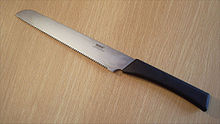Bread knife


Bread knives are used for cutting bread and are one of many kitchen knives used by cooks. The serrated blades of bread knives are able to cut soft bread without crushing it.
History[edit]

One such knife was exhibited at the World's Columbian Exposition in 1893 in Chicago by the Friedrich Dick company (Esslingen, Germany).[1] One design was patented in the United States by Joseph E. Burns of Syracuse, New York.[2] His knife had sections of grooves or serrations, inclined with respect to the axis of the blade, that form individual small cutting edges which were perpendicular to the blade and thus cut without the excessive normal pressure required of a scalloped blade and without the horizontal force required by positive-raked teeth that would dig into the bread like a wood saw. There were also sections of grooves with the opposite direction of inclination, separated by a section of smooth blade, and the knife thus cut cleanly in both directions in both hard and soft bread.
Measurement[edit]
Bread knives are usually between 15 and 25 cm (6 and 10 in). An offset serrated knife uses an offset handle to ensure the cook's knuckles will not touch the cutting surface when the blade has cut all of the way through the food. [citation needed]
References[edit]
- ^ "We are producing serrated knives thus bread knives since we started the production of knives in 1889." "Series 1893 means that in this year, Friedr. Dick exhibited during the biggest international fair in Chicago"
- ^ US patent 1388547, J. E. Burns, "Cutting Tool (filed Sept. 25, 1919)", issued 1921-08-23
External links[edit]
- "The Serrated Bread Knife," Chronicle of Early American Industries, 2010 - article documenting the production of American serrated knives and saw-cut knives back as far as 1838.
